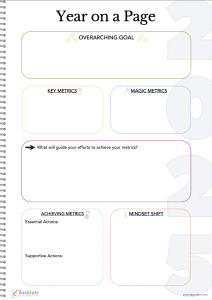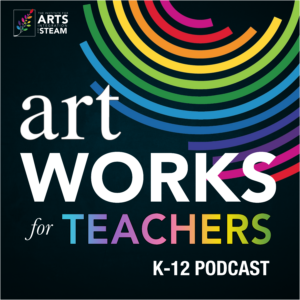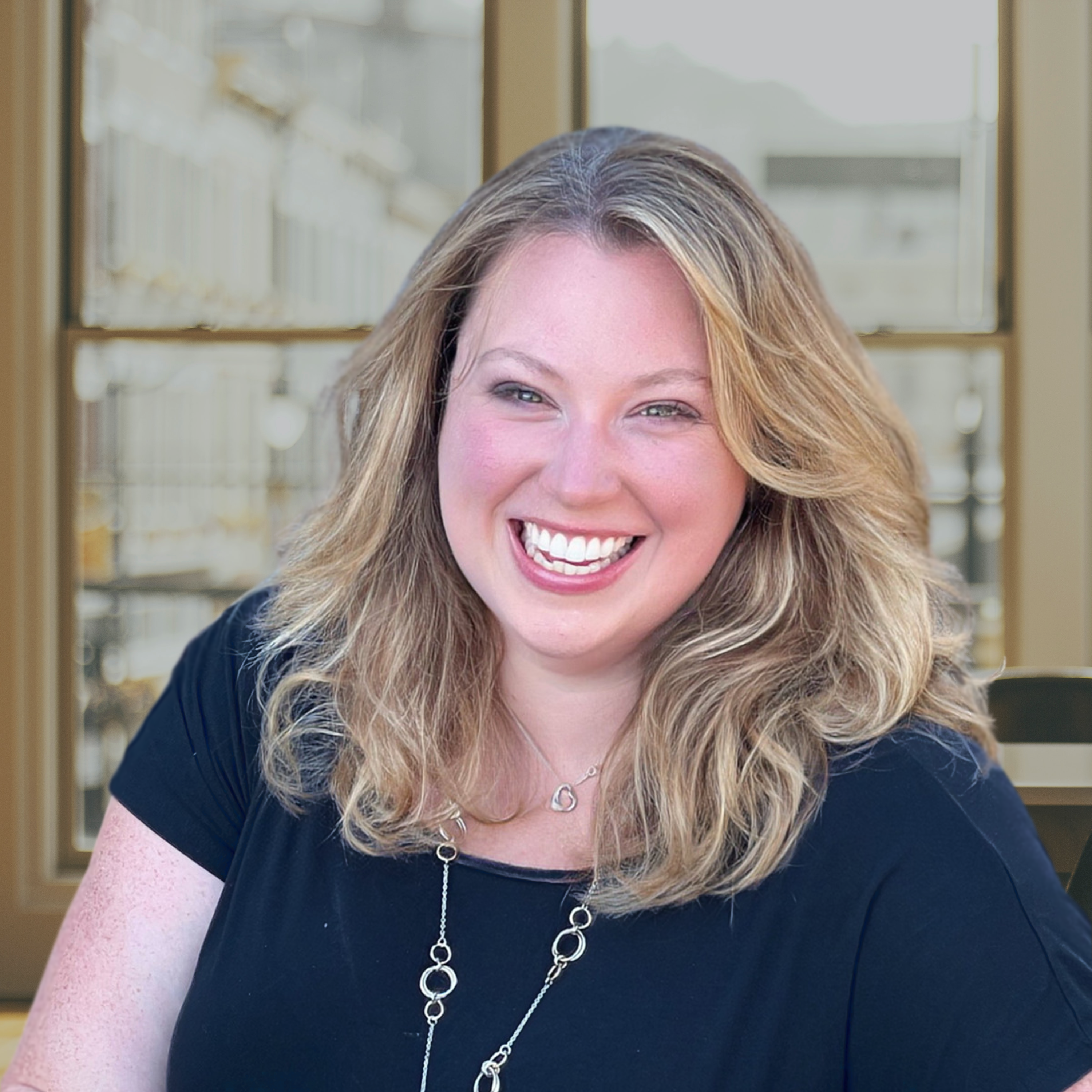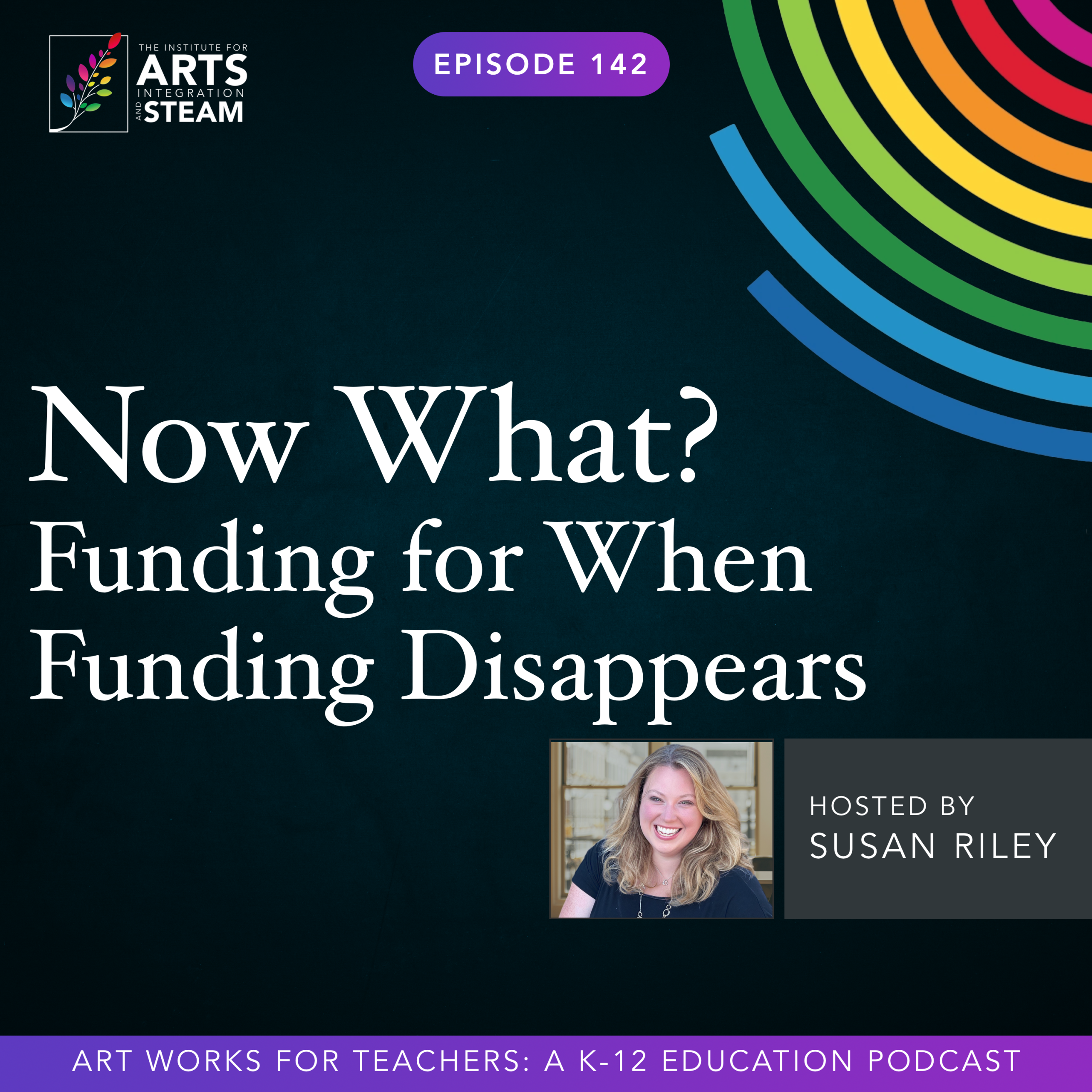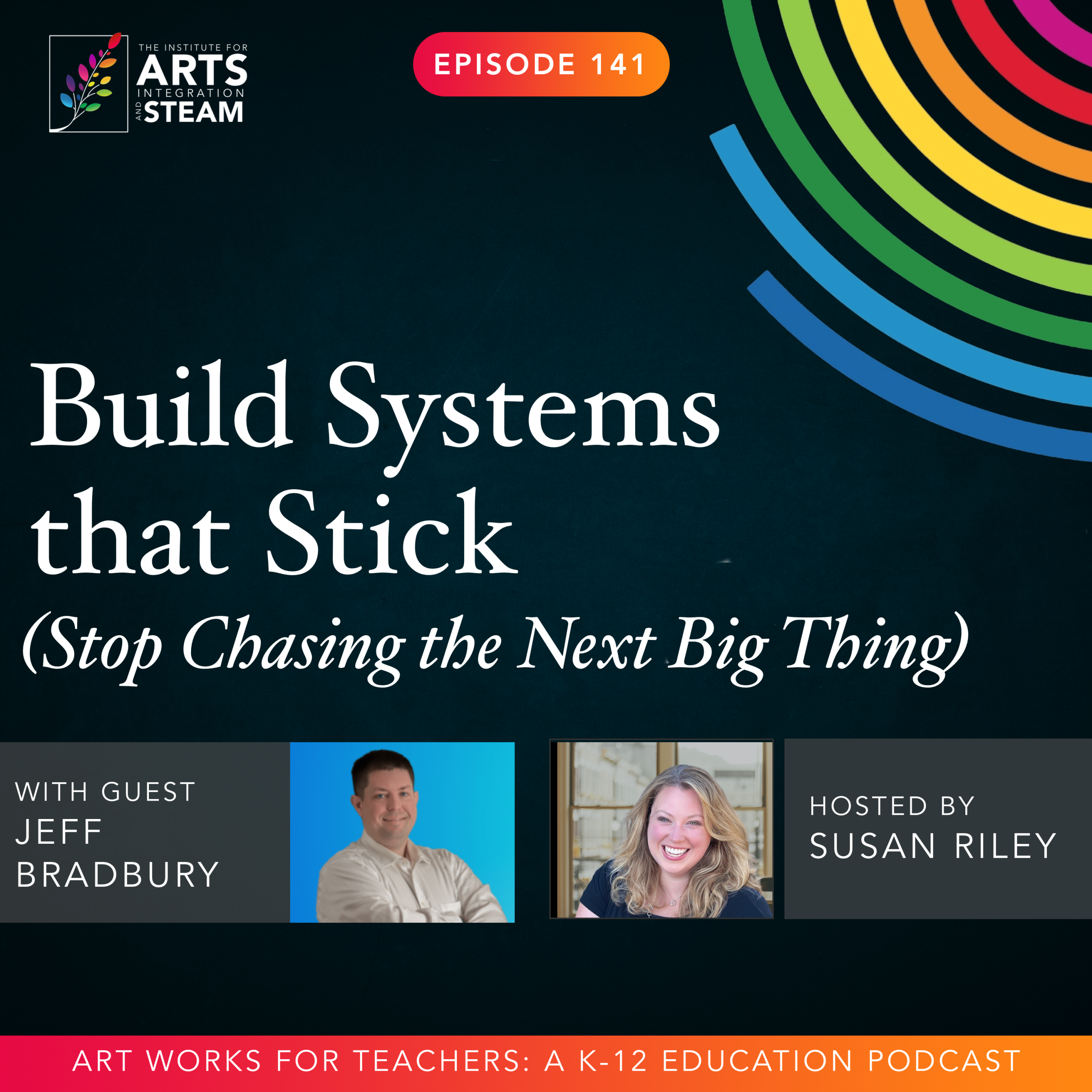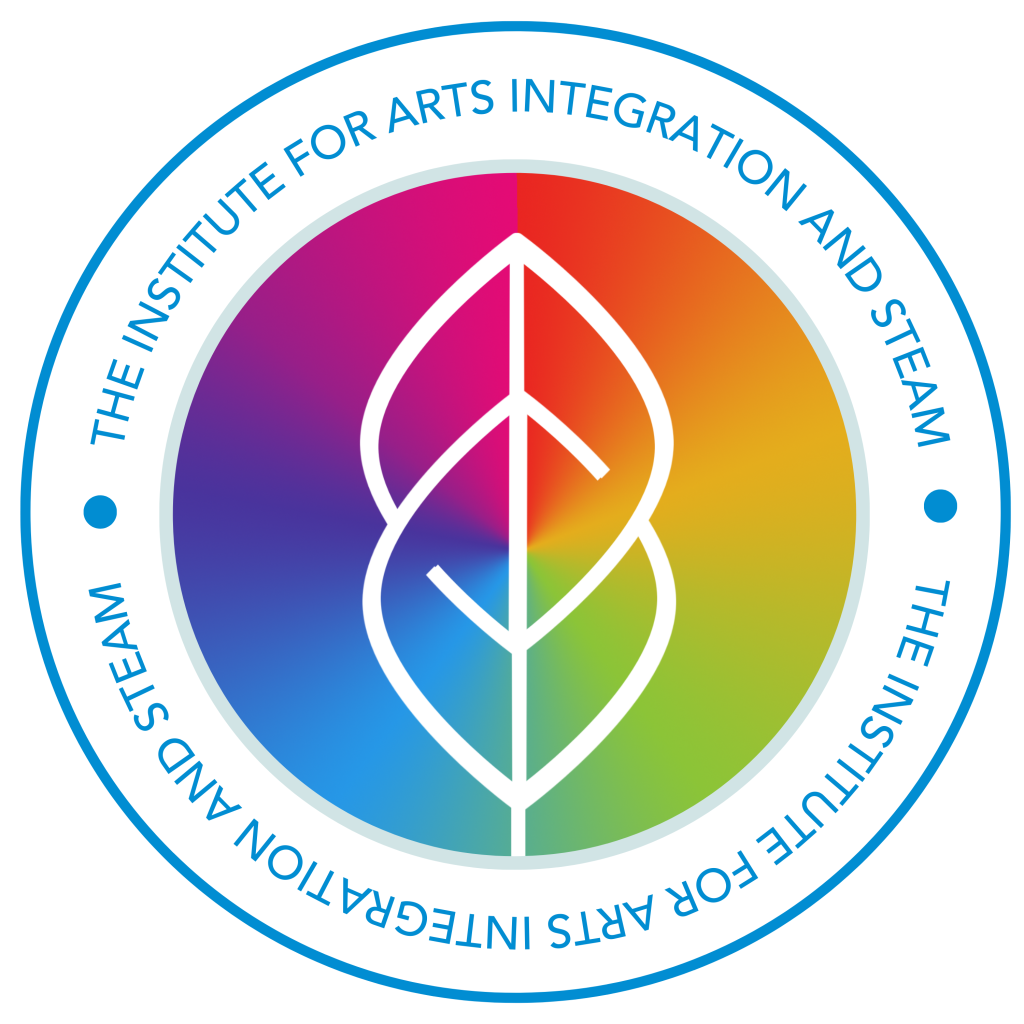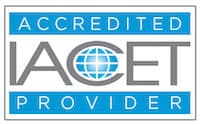ART WORKS FOR TEACHERS PODCAST | EPISODE 116 | 37:36 MIN
Year on a Page
Ready to start the year with purpose and focus? Learn how to turn past successes into a springboard for growth, and discover how driving questions can shape your decisions all year long. With tips on productivity, accountability, and building teacher support, this episode will inspire you to hit the ground running and make this your best year yet!
I think we’ve all done it all, Like the word of the year, that was big for a long time. I saw a little bit about that this year, not as much as I have in years previous, but you know, picking one word to guide the rest of your year. Somehow at this time of year in January, the time of this recording, we have this obsession with cleaning house, with somehow getting ready to have a better life in some way, right? And who can blame us, right? It’s a new beginning, new year, fresh start. But for us educators, it’s really the middle of the year, right? So our new year actually begins in either August or September whenever we start school, right? So that’s when all of that picks up for us. So it feels a little weird. I have always felt as an educator, it felt a little weird to try to… kickstart or restart in January when I’m like smack in the middle of my school year. Now it does help that sometimes our classes roll over as a new semester begins if you’re in secondary schools, but you know still for the most part at this time of year it can be a little strange as an educator. That said, I do find that this is a good time of year to assess where you are and where to move where you want to go forward. So as for our organization, we are starting a brand new year. We’ve got a new focus for 2025. And we’re actually at the time of this recording, at the time of when you’re listening to this, we are just finishing up on our annual team retreat. Now, we are a virtual organization, right? So we are spread all over the country.
We used to have most of our folks in Maryland and then everybody decided to up and move during COVID. So we’re all spread out. And so this is a way for us to get together, to see each other. It’s not the same over Zoom. I think everybody knows that, right? So get to be with each other in person. Our team retreats also typically involve our spouses or our significant others or a friend. If you want to bring them instead of a spouse, you can, people who are important to us in our lives. And our team retreats involve both time to work together and plan for the year ahead, as well as downtime. So ways to connect with, reconnect with nature, with yourself, with your spouse, because all of that is important and adjusts who we are as people, right? It influences who we are as people. And so I think it’s important that we honor that.
And so our team retreat depends, it usually lasts between three and five days. This was a little shorter, but it was in Jamaica this year, so that we were celebrating a really great 2024. Our organization grew by almost 20 % last year, which just indicates to us that Arts Integration and STEAM are really gaining momentum around the country, and we’re excited to be able to serve more people. But of course, with serving more people,
That means that we have to account for more staff members, more resources, we have to think about and strategically plan how we’re going to be moving ahead. And it also allows us to reconsider some of our goals. Because, for example, last year we met our five-year vision a year early. Our five-year vision was to impact over a million students in schools with Arts, Integration and STEAM strategies. And last year we did it.
So it also requires us to look at are the goals that we set for ourselves still goals that we want to pursue? Or do we need to expand those or drop something that no longer fits for our audience and for our organization? And there’s a lot of big things happening in 2025 for us. I’m excited to share that I’m finishing up my first book and that’ll be out for release at the beginning of 2026.
We are having our very first in-person conference in Baltimore, Maryland and expecting over a thousand attendees to that. So we have so many exciting things planned for that. We have over 60 sessions with presenters from all over the globe, my friend. I mean, Italy and Argentina and so many other places. So it’s the most diverse offering of sessions we’ve ever had.
We are planning to go really big into this event. And so that is, it’s new for us. So we have to plan for some new ground. And then additionally, we have decided to fully upgrade our accelerator platform. Our accelerator has been around for five years and has seen incredible results with school systems and districts and classrooms all around the world.
But it is also, it’s time to upgrade it. It’s time to make it a little bit faster to add some more security protocols to make sure that it’s in compliance with all schools everywhere. To make it a little bit easier to log in, to streamline what’s in there because those of you who are Accelerator members, know just how much is in there. And we wanted to really consider and be thoughtful about the user experience in the Accelerator.
Because one of the things that we hear is that all of the information is great and we love having it all in one spot, but it can be really overwhelming. So we’ve decided to partner with a developer out of the UK who does amazing work, has worked with Google and lots of other large organizations and some smaller ones to help us rethink and reimagine how the user experience is optimized for the accelerator. And I’m really excited for those updates to happen. Plan for those to launch in July at our conference. We cannot wait to showcase that. So lots and lots of really good things coming this year. And if you’re thinking about your year and what you have planned for 2025, even if it’s not the full 2025, even if it’s just for from now until the end of the school year, even if it’s just for those six months, I want you to be thinking about what are you really excited about?
What do you want to have happen? What are some things we need to let go of? Right? What are some things you need to let go of in order to achieve the goals that you have to achieve? And how are you going to plan for that? How are you going to set yourself up for success? And that is really what today’s episode is about. It’s called your year on a page. And I want to share with you how I’ve worked on streamlining all of these ideas that I just shared with you and how to think about all of this on a single page that I can reference all year long. And I wanna share that with you because I think it will be really helpful to you as well. Because no matter how much you have going on, if you can simplify and streamline and put it down on a single piece of paper that you can refer back to week after week after week, I promise you this, you are gonna hit your goals. You’re going to be able to feel more managed, you like manageable, and it’s not going to feel as overwhelming as it might appear or feel right now. One of the things that I recognized as our team was meeting and we were talking about all of the things that we plan for the year ahead is that until we wrote everything down, it felt just so overwhelming in our heads, right? Like we’re talking about it and as we’re talking about it, we have this, we have this, we have this and I could feel my anxiety rising. Have you ever been in those meetings in your school where you’re like, everybody’s talking about, here’s what we have to cover and here’s what we have to do. And you can just like, you can start to feel your heartbeat going a little bit faster. You feel your anxiety rising a bit. And so then you go to capture it all on paper, right? Cause that’s the first thing that we always say, get it out of our head and get it onto a piece of paper. That’s the easiest way to start to calm some of that anxiety. So, we put it on a piece of paper, right? And we put everything down that we want to accomplish, the things that, the steps that we’re going to need to take to get there, all of those things. And then the anxiety comes down a little bit, but you’re still looking at it going, my gosh, how am going to get all of that done? And sometimes in our organization, our checklists for things are pages upon pages long.
Right? So I can tell you right now, our planning for conference, like it’s like five pages long of just check, check, check, check, check, check boxes. So it’s a lot, right? And if you’re planning your curriculum or if you’re looking at, at planning a program that you want to kick off, or if you’re thinking about even how you’re going to balance your schoolwork with maybe a course that you want to take in order to get that pay bump or, you know, your daughter’s soccer practices and dance practices in addition to all the stuff you have to do at home. Again, even if you put it all on paper, it can feel overwhelming and it can be anxiety written, right? So this year I determined, okay, let’s take a look at all the things, everything that we have written down on paper and see if we can get it streamlined to the point where it can fit on one page. Because a couple of reasons why. One, one page is easy to consume.
Right? It’s not overwhelming. You can do anything that is on a single piece paper. Two, you can carry that piece of paper with you anywhere. You can stick it in your planner. You can stick it in your wallet. You can stick anywhere. It can come with you. It’s easy to travel, right? And constantly be a reminder. Three, if you’re referencing this piece of paper, this overview for your year,
And you constantly keep looking at it. You have it available to you. Have it easily accessible. The reality of you hitting whatever it is that you’ve put as goals for that year, managing and doing the things that are on that paper, it is so much higher that you will actually succeed at it if it’s on a single piece of paper than if it’s on multiple pages, right? And so often when we’re journaling or we talk about our practice for getting into journaling for the year. We think about, you know, filling pages and pages of ideas and brainstorms and all of that. And that’s all great. But I really think the action is being able to have it on a single paper. And so the way that we did that for this year, I’m going to break it down for you. And I hope that you can take this and use it for your own, whatever it is that you’re planning for in 2025 or to your head.
We have a template for you that goes with this episode. So make sure you go over to artsintegration.com forward slash artworks and look for the episode on the year on a page. You’ll be able to download that template for free and then you can just use that to have your your overview for the year ahead. Okay, so here’s the first thing that we did. We decided what our main goal was going to be.
So we picked out of all the things that we wanted to accomplish, we thought about, okay, is there a similar thread? Is there a common thread that could go through all of these big projects that we have coming up? And I shared what they were. So we took a look at, we had a goal for how many people we wanted to impact. So our goal is the overall impact goal of how many people do we want to have participating and joining us for all of these events, right? Because each event we have the conference, we want to see a thousand people there and we want to increase our newsletter subscribers and we want to increase our social media reach and all of these things, all that has in common is how much reach do we want to have for 2025? So we decided that’s our main goal for the year, right? And then out of that, we have an alignment of key metrics. So these are things that these are going to have or how we know we’ve hit this goal, right? So our overall impact goal for 2025 is 2 million educators from around the world. And so our metrics are how many of those are Accelerator members? How many of them are coming to conference? How many of them are a part of our newsletter subscriptions or our free newsletters every month? How many of them are level ones certification candidates, how many of them are school certification candidates. And literally we broke that down by the key programs that we have going on in the year so that we could see at the end of the year whether or not we hit it. And we know that if these metrics are true and we hit each of these metrics, then we’re going to hit our overall goal. Okay. I think that’s the most important thing that you can do is decide what’s your overall goal. The common thread through everything that you want to accomplish? And then what are the metrics that you are going to use to track that over time? Because when you have metrics, you can start to say, OK, if I would like to see 2,400 new accelerator members in our group by the end of 2025, then I can break that down by month. And then how am I hitting that every single month? Are we attracting those members to us? And are we serving them in the best way possible, right? So once you have your big goal and your metrics, that’s an easy way that you can begin to really move the needle and take action. Remember, the biggest piece on this whole idea of whenever you’re thinking about organizing your year or thinking about trying to be more productive or thinking about how to arrange your schedule in any capacity.
The overall idea is that it’s not enough to just put it on paper. You gotta do something that takes action. Because it looks great on paper. But if we’re not actually doing something to move the needle, it doesn’t really matter, right? It’s like when we’re filling out student learning objectives and we wanna increase student achievement by 5 % on this particular reading standard. That’s great, and I’m glad that we have a goal and a metric. But what are we doing to actually
move the needle on that, right? If we don’t set ourselves up and say, here are the things that I’m going to do to be able to hit that goal, then it doesn’t really matter. I can say anything I want on a piece of paper, but is it going to matter at the end of the day? And I don’t want you wasting your time on something that doesn’t matter because that’s the worst thing we could do, right? So look at whatever projects that you have. Maybe it’s you want to start a steam club and you also want to make sure that your students are achieving at a specific capacity for whatever it is that you’re teaching and what you’ve decided. And maybe you also want to make sure that you are home for dinner every night at 5 p.m. because you want to spend time with your family. Those are all things that you want to accomplish. Look for the common thread. What is the common denominator on all of those things? Probably time. So you want to think about maybe getting more productive on your time and what that looks like. You want to be able to block off however many hours per day to commit to these particular goals. And then what are those metrics? So, you know, I’m gonna commit to that 5 p.m. being home and I’m gonna commit to a one hour a week STEAM club after school and I’m going to commit to, you know, and set yourself up that way for your metrics. So having that at the top of the page is really important. And honestly, that takes up half of my page.
So on our page, have the overarching goal. then, and by the way, this does not have to be super pretty. We’re gonna make it pretty for you in the template, but my page is a list of bullets. It’s just bulleted items with some sub headers. That’s it. So it can be as simple as that. You can do it in your notes app if you want to. It doesn’t matter where you do it or what it looks like. It’s the items that make the difference, right? So if you have overarching goal, which is your common thread, the common denominator goes through everything that you wanna accomplish your key metrics. And then underneath your key metrics, I have something that I add called magic metrics. Magic metrics are things that you don’t know for sure, but you really are hoping to have as a part of the metrics to support your overall goal. So here’s what I mean by that. Lots of times when I’m creating a budget, whether it’s for our business or for our home,
I have my main budget, That here’s where everything fits, here’s all of our expenses, here’s what we have left over, and hopefully we have stuff left over, right? But then on the edges, I build this stuff called the magic metric, where I leave a little space for things that are unexpected, both in expenses and in income, right? So that’s that unexpected, like, car payment that you got back as a credit because it accidentally was overpaid last year and suddenly they did their books and they were like, you made an extra payment. Let’s credit that back. Like that unexpected check you get in the mail. Hopefully your IRS tax check comes back in the mail. You’re like, woohoo, I get a little money back this year. That’s that magic space. And then you also leave magic space for expenses, things that you weren’t anticipating, but maybe like are actually needed and you need to have space for that too. When you budget in for the magic, allows you to have a little bit extra space for things that, you know, are just surprises. And I have found that that is super helpful in planning my goals too. So when I have my goals, sometimes something comes up that was unexpected. For example, for us in the accelerator, we did not plan
to totally overhaul the accelerator in 2025. That was not on the radar. It wasn’t something we had really budgeted for. And I’m telling you, it is a huge investment. It’s enough of an investment that it made me swallow a couple of times thinking about it. But it’s so needed. And once we saw it, once we worked with Plume for a little bit and saw what their vision was and how it could make it the experience so much better for teachers, suddenly I couldn’t unsee it, right? Suddenly it was like, okay, this is a magic expense that we’re gonna need to figure out how to cover and we will and I don’t care how we do it, but it will, it’s important enough to make happen, right? When you’re thinking about your goals, there are gonna be opportunities that come up that you’re gonna go, I wasn’t planning for that. But now that I see it,
I can’t unsee it and I really want to do it. Okay. And it doesn’t matter what I have to do. I’m going to make sure that that happens. Leave a little space for magic. Okay. And so in your area, you might know what some of those magic things are like that you’re hoping to get like, I put in for that, that grant for the steam club. And I’m really hoping that it comes through. That’s a magic metric. Okay. You can put it in there.
And that leaves the door open. And I’m a big believer that what you put out there, whatever you think about is gonna come to you in some way. So putting it down on paper and giving it a name just makes it more real and calls it in a little bit faster. So in my example, our magic metrics is that we applied for a grant for the accelerator and so I’m hoping that that comes in.
We’re leaving a little extra space for sponsorships and exhibitors that we didn’t anticipate who might want to also participate in our conference and add value and such a great experience for our conference attendees. And also, leaving space for some investors. We’ve never looked at having investors before, and we’ve had some opportunities come up that might be a possibility for 2025. And so we just put that in our magic metric area of that could really like and support the work that we’re trying to do. We also put in our magic metrics being open to new team members that maybe we weren’t aware of in the past or that we know want and we just weren’t ready for it just yet, but maybe it’s the time now. So again, to support all of the bigger goal for us, that makes sense, right? So in yours, I want you to think about, you have your goal, you have your metrics, your key metrics.
What are some magic metrics that you might want to consider? What are some things that maybe you already have in the works or would be really awesome if it would happen this year? Even if it doesn’t happen this year, that’s okay. You just sprinkle some of that magic dust on there and see what pops up because sometimes what happens is that something even better than what you listed comes along. In fact, I’m a big believer of that you know, sometimes you can’t plan for the good stuff and it’s so much better than anything you could have imagined anyway. Okay, this is where that hopeful component starts for the beginning of the year and that’s why I get so excited about this. All right, so those three items take up about half of the page. Now, the second half of the page is how you’re going to get to those metrics, what you’re going to do in order, what actions you’re gonna take in order to get there.
and it’s broken into two parts. There’s the driving questions and then there’s the actual actions you’re going to take. So for a quarter of the bottom of the half of the page, the driving questions that are gonna get you to your goal. And so I’m gonna share with you our driving questions.
You can modify these to make them work for you, but I think that many of these questions are things that are universal and that are just a great question to ask ourselves, no matter what our goals are or what situation we are in. Okay? So the first striving question is, how do we make our work or who we are so attractive that people want to be a part of it? So this can apply to anything that you’re working on.
How do you make whatever it is, whatever your key goal is and all of your metrics, how do you make this so attractive to others that they also want to join in and be a part of it? Because I can promise you something, working on our goals alone is not going to be enough. We need to lean into our relationships and into our community of others who are here to support us, right? We can go alone, but you know, the old adage, you you want to go far, you you work with somebody together. So if you want to go fast, go by yourself. If you want to go far, work with somebody else. And so I’m telling you, having a community makes such a difference. And so think about how can I make this so attractive that others want to be a part of it? And what are some ways that that looks? So for us, that might be adjusting some of our branding, thinking about how we approach social media, what we’re how we’re showcasing other schools that are working with us so that others want to be a part of the amazing results that we’re seeing, right? Things like that. That’s how we could make it attractive. But if I’m thinking back to when I was teaching and I had programming that I wanted to have like a STEAM club, or if I wanted to invest in more family time for myself and having those kinds of things, I actually would think about, okay, how do I make the idea of me going home so attractive that other people in my community are going to hold me accountable to that, right? Like, I want to talk well about my family. I want to say like, not how overburdened I am or how like how much work this all takes, but I really love being home with my family. I love being able to fold laundry together and have that special family time. I love being able to teach my daughter how to cook. These are things that make going home attractive.
And when I would start to say that to my colleagues, when I was working late, they would come to my room and be like, you need to go home. Go home to that beautiful baby girl that you have. Go home to that husband who is making you that home cooked meal. Because they were invested in the way that I talked about it, right? So just that little mindset shift helped me tremendously to hold myself accountable and have others be invested in that for me, right? So even something as simple as that can make a big difference. But when you’re working on programming, that’s even easier, right? So thinking about like, here’s how this is gonna benefit our students and here’s how it’s gonna benefit our staff and get excited about it and share all the good stuff so that people wanna be a part and be play in your sandbox, right? So that’s your first question. What is no longer serving my goals or our community that we have to let go of looking at your goal, looking at what it is that you want to accomplish for 2025, what are you currently doing that is no longer going to serve you to get to that goal? And I promise you there’s something, whether it’s your current scheduling, whether it’s how you, the productivity tools that you use, whether it’s how you’re speaking about whatever it is, I promise you there’s something that you have to let go of in order to achieve the goal that you want to achieve. You just have to look for it. And not only do you have to look for it, when you find it, you have to have the courage to let it go. And that’s the hardest part. Because sometimes it’s stuff that is so entrenched in us that we think, there’s no way I could let that go. I have so many other responsibilities here, here, here, and here. But the big thing that I want you to think about is there’s always a way to let it go. What does that mean? Is it going to be comfortable? Probably not.
But what does that mean? Because every time you say yes to something else, you’re saying no to some of your goals. So consider that and then think about what is it that I need to have the courage to let go of this year in order to hit that goal. And if it’s an important enough goal for you, you’ll let it go. Number three, what can we simplify to ensure our focus stays on the goal? Right? So this is another really important piece. We tend to overcomplicate things as humans. We want to make as many steps and intricacies as possible. And sometimes there’s just, it doesn’t need to be so complicated. We can simply streamline some things. We can simplify some things. Again, this is hard. We talk about this in our organization a lot because arts integration, STEAM, these are things that are complicated in their very nature.
Right? But we don’t need to overcomplicate them. So when we start looking at our own processes and working with groups or onboarding people or like anything that we’re working with people that could possibly overwhelm them, how can we streamline that? How can we simplify some of those things to make it a better experience for everyone? The same is true for you and your goals. Right? How can I simplify some things in order for me to achieve the goal that I’ve got set up top?
All right, and the last one, what am I committed to going pro on? And what does that look like to me? Okay, now, going pro is a kind of idea that Steven Pressfield wrote about in his great book about going pro. And so if you need a refresher on what that means, I would highly recommend his book to you. But the general idea is, professionals do things differently than amateurs, right?
If we are a hobbyist at something, we dabble in it, but we don’t necessarily take it as seriously as a professional would, right? So in order for us to accomplish the goal that we have set, is there an area where you really need to focus on it like a professional in order for it to be achieved? So let me give you an example. So for our goal of impacting 2 million students, right? That means for us in order to go pro,
We really need to consider how our video messages come out and what they look like and getting them to be engaging for people to want to consume that content more than they are right now. Because right now, we’ve just kind of been putting out content to be able to share it. But professionals don’t do that. Professionals use professional equipment and they hire people to be able to edit and copy things and put them together in a way that’s engaging to others. And they know the current trends and they stay up on the current trends. And so for us, we need to invest in some of that in order to go pro in that area so that it can attract more people to us, right? So going pro doesn’t necessarily mean you have to buy things, but it does mean that you have to commit to something in a professional way rather than as an amateur way, right? Rather than just dabbling in it. So think about your goal.
What is something that you need to go pro on in order to achieve the goal that you’ve got set for yourself? Okay, those are your four questions that you’re going to answer. And those four questions are so enlightening. And they will also be a great reminder to you. Literally, I don’t have anything, I don’t have the answers to those questions on this page. I just have those questions available to me so that anytime I’m having to consider a decision that I have to make, I can look at those decisions and be like, is this
What about this is going to make this more attractive to people and want to have them want to join our community? What about this does not serve our goal? Is there anything about this that doesn’t serve our overall goal? Is there something about this that I could simplify in order to make sure that it’s as streamlined as possible? And is there something in this that is going to allow me to go pro in this area so that I can achieve my goal faster? Having those questions available to you at all times is such a help when you’re trying to make decisions about opportunities or things that come along that you need to consider as to whether or not it’s going to help you achieve your goal. And then finally are your action steps. What are three specific actions that you are committed to doing on a daily basis to hit your goal? Okay, and so these can’t just be things that you check off as a task. These have to be consistent actions that you are going to take in order to hit your goal. For example,
If your goal is to spend your time more productively this year, right, and not have as many gaps, then you’re gonna wanna put into place a time tracker. And you’re gonna complete that time tracker every single week, right? Probably daily if you really wanna be great about it. So that’s one of your checklist items. It’s one of the actions that you are just going to take in order to hit your goal, right? That you’ve done a time tracker for this week or this day, right?
Another way that you’re gonna be able to do another action that you’re gonna take is that you are going to leave work every single day at 5 p.m. or whatever it is that you decide, right? That’s an action that you are going to take in order to achieve that time balance that you’re looking for. So think about what are actions, specific actions that you are gonna take that are gonna help you move the needle on the metrics that are up at the top of this page. And literally that’s it. These are the four sections that I’ve got on my year at a page. And I’m so excited about it because I can just put it there and look at it and it’s going to help me get to that overall goal. I cannot wait to report back at the end of 2025 as to whether or not we hit it. And I would love for you to join me in that. So go and download the template that’s over at today’s episode year on a page over at artsintegration.com forward slash artworks. Fill in your goal and your metrics.
Get those four questions as driving questions to be considering as you’re working towards your goal and the specific actions that you’re going to commit to taking this year to achieving your goal. And then let me know what your goal is. I want to be able to support you in it. So find me over on social media. We are at arts int edu at all major channels, Instagram, YouTube, Facebook, all the places. DM me and let me know what your goal is for this year, because I want to support you in it. I want to be a part of the community that’s cheering you on.
All right, enjoy this process and I cannot wait to see you on another episode of Artworks for Teachers.

